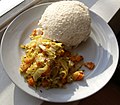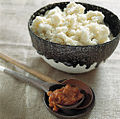Ugali
Maize meal (also known as mielie meal, or ground white maize ) | |
| Similar dishes | |
|---|---|
Ugali, also known as posho, nsima, and other names, is a type of corn meal made from maize or corn flour in several countries in Africa.[1] It is cooked in boiling water or milk until it reaches a stiff or firm dough-like consistency.[2] In 2017, the dish was added to the UNESCO Representative List of the Intangible Cultural Heritage of Humanity, one of a few foods in the list.[3]
Names

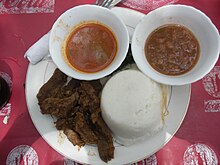
This dish is eaten widely across Africa, where it has different local names:
- Agidi – Igbo, Nigeria
- Akple – Togo
- Aseeda – Sudan
- Busuma [Bukusu] – Kenya
- Bando – Soga, Uganda
- Bidia – DR Congo[4]
- Bogobe/Phaletšhe – Botswana, South Africa
- Bugali – Burundi, DR Congo, Sudan, South Sudan Rwanda
- Buhobe – Lozi[5]
- Buru – Luo
- Busima – Bagisu, Uganda
- Chenge – Kenya, Luo
- Chima – Mozambique
- Couscous de Cameroon – Cameroon
- Dona
- Fitah – Sudan, South Sudan, Congo
- Foutou – Ivory Coast
- Fufu – Sierra Leone, Nigeria
- Funge de milho – Angola (northern)
- Sadza – Kalanga, Botswana and Zimbabwe
- Isitshwala – Botswana, Zimbabwean Ndebele
- Isishwala – South Africa, Bhaca people
- Kawunga – Ganda, Uganda
- Kimnyet – Kalenjin, Kenya
- Kuon – Luo
- Kwen wunga – Alur, Uganda
- Lipalishi – Eswatini
- Mdoko – Zulu, South Africa
- Mieliepap – Lesotho,[4] South Africa[4][6]
- Mogo – Kenya, Luo
- Moteke – DR Congo[4]
- Mutuku – South Africa[4]
- Nfundi – Congo[4]
- Ngima – Kamba, Kikuyu, Embu, Kenya
- Nkima – Kenya, Meru
- Nshima – DR Congo Kasai region
- Nsima – Malawi,[4] Zambia[4]
- Obokima – Kenya, Kisii
- Obusuma – Kenya, Nyole tribe[7]
- Eko – Nigeria, Yoruba
- Oshifima – Namibia Ovambo
- Paliche - Botswana (Setswana)
- Pap – Namibia, South Africa[8]
- Papa/Bogobe – Lesotho,[4] South Africa[4]
- Pâte [French] – Togo, Benin
- Phuthu/phalishi – Zulu people, South Africa[9]
- Pirão – Angola (southern)
- Posho – Uganda[10]
- Saab – Ghana, Kusasi
- Sadza – Shona[4][11]
- Sakora – Nigeria
- Sakoro – Ghana
- Sembe – Tanzania, Kenya slang
- Shadza – Kalanga, Botswana
- Shima
- Shishima – Zambia
- Sima – Kenya, Chewa,[12] Tumbuka, and Ngoni[5]
- Soor – Somalia,[4] Zambia[4]
- Tuozafi (or T.Z.) – Ghana
- Tuwo – Hausa, Nigeria
- Ubugali – Rwanda
- Ubwali – Bemba[5]
- Ugali – Kenya,[4] Malawi, Mozambique, Tanzania,[4] Uganda,[4] Yao, Swahili
- Um'ratha – Ndebele people, South Africa
- Upswa – Mozambique[4]
- Bohobe – Sotho, South Africa, Lesotho
- Vhuswa – Venda people, South Africa
- Vuswa – Tsonga people, South Africa
- Wari – Mijikenda tribes, Kenyan Coast
- Xima – Mozambique[4]
Etymology
The word ugali is an
History
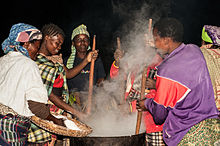
Ugali was introduced in Africa shortly after the Portuguese had introduced maize. The Luhyas in Kenya were the first to end up with ugali, as they tried to cook thick porridge from maize flour. Maize was introduced to
Varieties
African Great Lakes
Ugali (when it is cooked as porridge, it is called uji) is served with sweet potatoes, ripe bananas, Irish potatoes and even bread. Solid ugali is usually served with traditional vegetables, stew or sukuma-wiki (also known as collard greens).[17] It is the most common staple starch featured in the local cuisines of the African Great Lakes region and Southern Africa. When ugali is made from another starch, it is usually given a specific regional name.[18]
The traditional method of eating ugali (and the most common in rural areas) is to roll a lump into a ball with the right hand and then dip it into a sauce or stew of vegetables or meat. Making a depression with the thumb allows the ugali to scoop, and wrap around pieces of meat to pick them up in the same way that flatbread is used in other cultures. Leftover ugali can also be eaten with tea the following morning.[19]
Ugali is relatively inexpensive and thus easily accessible to the poor, who usually combine it with a meat or vegetable stew (e.g., sukuma wiki in Kenya) to make a filling meal. Ugali is easy to make, and the flour can last for a considerable time in average conditions.
Ghana



Sagtulga (Dagbani:saɣituliga, Hausa:tuo zaafi), or diehuo, is a popular main dish for the people of
The dish consists of cooked maize dough with a little dried cassava dough and water without salt.[21] Traditionally, it is prepared with millet dough[22] which is indigenous to Ghana's north.[23]
It is mainly eaten with green vegetable soup made from bitter leaves, or sometimes freshly pounded cassava leaves. It can be accompanied, however, with a variety of soups including okra and groundnut soup.
Kenya
In

Ugali is prepared from ground white corn similar to how tamales are made from yellow corn in Central America. In most homes the ugali makes up most of the meal, with vegetables or meat as accompaniments. In wealthier homes, or for special occasions, the ugali is served with abundant savory vegetables and meats in spicy gravy. It resembles mashed potatoes served in American homes. In Kenya, a smidgen of thick ugali is grasped in hand and the thumb is depressed in the center to form a spoon for scooping—a form of edible silverware. While the thumb and fingers may get a bit messy with this method, the way of eating food is culturally significant in the region.
Malawi, Zambia
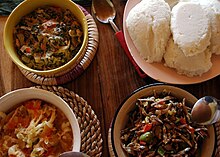
Nsima is a dish made from maize flour (white cornmeal) and water and is a staple food in Zambia (nsima/ubwali) and Malawi (nsima).[24]
The maize flour is first boiled with water into a porridge.[25] and, in Zambia, left to simmer for a few minutes before it is 'paddled', to create a thick paste with the addition of more flour. This process requires the maker to pull the thick paste against the side of a pot with a flat wooden spoon (nthiko in Malawi, m'tiko/umwiko in Zambia) quickly whilst it continues to sit over the heat. Once cooked the resulting nshima/nsima is portioned using a wooden/plastic spoon dipped in water or coated in oil called a chipande(Malawi), and chipampa (Zambia). In Malawi each of these portions is called a ntanda.[25]
Nsima is always eaten with
Traditionally, diners sit around a table or on the floor surrounding the meal. The diners have to wash their hands as nshima/nsima is eaten with bare hands. This is done with a bowl of water. Alternatively the host or one of the younger people present pours water from a jug over the hands of the elders or guests into a bowl. Eating is done by taking a small lump into one's right palm, rolling it into a ball and dipping it into the relish. Using the right thumb to indent the nshima ball is a technique used by advanced nshima diners in order to easily scoop the relish or sauce of the dish. In Zambia, umuto (Bemba language) refers to the drippings/broth/sauce of a side dish or stew; and the act of scooping an ample amount of it with a nshima ball is called inkondwa. The statement, "umuto wankondwa" loosely translates to "sauce to allow for inkondwa". As with many African traditions, age is very important. Washing before the meal, eating, and washing after the meal generally starts with the oldest person, followed by everyone else in turn by age.
Nsima is relatively cheap and affordable for most of the population, although occasionally prices have risen due to shortages, contributing to economic and political instability.
Nigeria
In
. There is also the thicker variety, called Eko among the Yorubas, Agidi among the Igbos. The pudding is cooked on heat until it is thicken. It is traditionally wrapped in leaves with botanical name Thaumatococcus daniellii.[27] Yorubas call it Ewe Eran while the Igbos call it Akwukwo Elele.[28] It is usually paired with a variety of vegetables soups and sauces for a light meal or it can be eaten with beans or its by products.South Africa
Pap,
A variety of
South Africans in the northern parts of South Africa eat it as the
In the
In the northern provinces pap is usually soft and made using a fermented maize batter which prevents the pap from spoiling quick due to the fact that northern provinces are much hotter than the south.

Uphuthu is a South African method of cooking
Phuthu or Uphuthu (/ˈpʊtuː/), also incorrectly spelled as putu or phutu, is a traditional preparation method of maize meal in South African cuisine. It is a crumbly or grainy type of pap or porridge, eaten by most cultural groups in South Africa. Phuthu is often eaten with meat, beans, gravy and sour milk.
The texture and consistency of uphuthu is often a deciding factor in what dishes will accompany it. For example, amasi or mass is usually prepared with a more finely-textured phuthu, whereas stews and curries are often served with a more clumped variety, leaning towards stiff-pap. Finely-textured phuthu has a tendency of being severely dehydrated (dry), depending on the cook's skill in working the dish. Such a severely dehydrated phuthu would often be served with stews, leafy vegetables, and many other savoury dishes containing moisture. Conversely, such dehydrated phuthu would not be suited to a dish of amasi or mass, because the steeping or soaking process would result in a paste-like dish, whereas amasi is preferred to be chewy.
Zimbabwe

Sadza in
Sadza is made with finely ground dry maize/corn
Zimbabweans prefer white maize meal. However, during times of famine or hardship, they resorted to eating yellow maize meal, which is sometimes called "Kenya", because it was once imported from that nation. Before the introduction of maize, sadza was made from mapfunde finger millet. In recent times, young people in Zimbabwe tend to prefer rice to sadza or isitshwala.[34] The Grain Millers Association of Zimbabwe (GMAZ) National Chairman Tafadzwa Musarara commented that the future working class will be eating less sadza and more of rice and bread as alternatives.[35]
Sadza is typically served on individual plates, but traditionally sadza was eaten from a
Notable foods eaten with sadza include:
Meat is known as nyama in Shona.
- game meat
- Cow hoof– mazondo, amanqgina
- Oxtail
- Other food stuff include intestine (tripe), offal, zvemukati (includes mathumbu, maphaphu, isibindi, utwane, ulusu, umbendeni; in Shona known as matumbu), sun-dried vegetables known as Mfushwa and many more
- White meat – includes huku – chicken meat, fish
- Fish (hove in Shona), including the small dried fish Kapenta
- Mopane worms / madora – edible moth caterpillar
- Spring greens – known as imibhida in the Ndebele Language, muriwo in the Shona Language
- Sugar Beans– known as nyemba in Shona
- Cabbage
- Derere – okra
- Cleome gynandra (ulude in Ndebele) / nyevhe in Shona
- Pumpkin – leaves known as muboora in Shona
- Soured milk natural yogurt (known as amasi in Ndebele or Nguni languages in South Africa, mukaka wakakora in Shona, or lacto
- Soya Chunks
- Soups and stews
- Ox bone
Similar dishes
Similar dishes are polenta from northern Italy, gh'omi (ღომი) from Georgia, and grits in the southern United States.
Fufu, a starch-based food from West and Central Africa, may also be made from maize meal, in which case it may be called fufu corn. In the Caribbean, similar dishes are cou-cou (Barbados), funchi (Curaçao and Aruba), and funjie (Virgin Islands). It is known as funche in Puerto Rican cuisine and mayi moulin in Haitian cuisine.[37]
Dishes similar to pap include banku, isidudu, and umngqusho.[citation needed]
Gallery
-
Ugali and cabbage
-
Phutu, pictured with tomato-based relish in the foreground
-
A meal of sadza (right), greens, and goat offal. The goat's small intestines are wrapped around small pieces of large intestines before cooking.
-
Ugali and usipa (small fish), staples of the Yawo people of the African Great Lakes
See also
- Chapati
- Cornmeal
- Fufu
- Grits
- List of African dishes
- List of maize dishes
- List of porridges
- List of soups
- Malawian cuisine
- Moin moin
- Mămăliga
- Polenta
- Tuareg food
References
Citations
- ^ "Ugali - a Kenyan cornmeal". Taste Of The Place. 16 October 2017. Retrieved 23 August 2018.
- ^ "How to prepare ugali/posho". Yummy. 4 May 2015. Retrieved 23 August 2018.
- ^ "UNESCO - Nsima, culinary tradition of Malawi". ich.unesco.org. Retrieved 26 June 2021.
- ^ a b c d e f g h i j k l m n o p q r McCann 2009, p. 137.
- ^ a b c Tembo, Mwizenge S. "Nshima and Ndiwo: Zambian Staple Food". Hunger For Culture. Archived from the original on 24 February 2017. Retrieved 18 February 2018.
- ^ "Mealiepap, n." Dictionary of South African English. Dictionary Unit for South African English, 2018.[1] 25 February 2019
- ^ "Kenya Information Guide Home page". Retrieved 24 June 2013.
- ^ "Pap, n." Dictionary of South African English. Dictionary Unit for South African English, 2018. [2] 25 February 2019.
- ^ "Putu, n." Dictionary of South African English. Dictionary Unit for South African English, 2018.[3] 25 February 2019.
- ^ "Ugandan food recipes - POSHO (UGALI) – Wattpad". www.wattpad.com. Retrieved 23 August 2018.
- ^ "Sadza, n." Dictionary of South African English. Dictionary Unit for South African English, 2018. [4] 25 February 2019
- ^ Gough, Amy (2004). "The Chewa". The Peoples of The World Foundation. Retrieved 18 February 2018.
- ^ "Tanzanian Ugali / Nguna Recipe". Gayathri's Cook Spot. 1 September 2015. Retrieved 23 August 2018.
- ^ McCann 2009, p. 139.
- ^ "Food & Daily life". Our Africa. Retrieved 7 May 2015.
- ^ Emma Kambewa (November 2010). "Cassava Commercialization in Malawi" (PDF) (MSU International Development Working Paper). Archived from the original (PDF) on 4 March 2016.
- ^ "Ugali & Sukuma Wiki". Rehema Home. Retrieved 6 June 2023.
- ^ "HOW TO COOK THE PERFECT UGALI / Nairobi Kitchen". HOW TO COOK THE PERFECT UGALI / Nairobi Kitchen. 15 July 2017. Retrieved 19 May 2020.
- ^ App, Daily Nation. "Fancy a piece of ugali cake with your tea?". mobile.nation.co.ke. Retrieved 29 May 2020.
- ^ "Corchorus olitorius Jew's Mallow, Nalta jute PFAF Plant Database".
- ^ "Ayoyo soup and tuo zaafi". infoboxdaily.com. Archived from the original on 27 May 2015. Retrieved 27 May 2015.
- ISBN 978-1-57356-290-4. Retrieved 2 October 2018.
- ^ "An Introduction to Northern Ghana's Super Foods Shea, Millet & Fonio | Circumspecte". Circumspecte. 25 July 2016. Retrieved 20 June 2017.
- ^ "Nsima". CooksInfo. Retrieved 29 May 2020.
- ^ a b "Nsima: The staple food of Malawi". experiencemalawi.com. Archived from the original on 6 May 2015. Retrieved 7 May 2015.
- ISBN 978-0-8247-8294-8.
- ^ "Moi-moi leaf plant prevents kidney, liver damage". The Guardian Nigeria News - Nigeria and World News. 8 November 2018.
- ^ "Moi-moi leaf plant prevents kidney, liver damage". 8 November 2018.
- ^ "Putu pap / Krummelpap / Crumbly porridge | Rainbow Cooking".
- ^ "Phutu Recipe (African Maize Flour Porridge)". EpersianFood. 7 April 2020. Retrieved 29 May 2020.
- ^ "TINK". frankline-ozekhome.squarespace.com. Archived from the original on 6 February 2021.
- ^ Rosengarten, David (3 October 2012). "Foods of South Africa: The Roots". Wine4Food. Retrieved 29 May 2020.
- ^ "Traditional Plain Zimbabwean Sadza Recipe". Ethnic Foods R Us. Retrieved 24 May 2020.
- ^ "Students fed up with Isitshwala and cabbage – #Asakhe – CITE". Retrieved 24 February 2024.
- ^ "'Young Zimbabweans prefer rice to isitshwala' – #Asakhe – CITE". Retrieved 24 February 2024.
- ^ "Sadza". worldfood.guide.
- ^ Kadet, Anne (31 July 2018). "New York City's 'Little Haiti' Makes a Big Impression". wsj.com. Wall Street Journal. Retrieved 18 December 2023.
General and cited sources
- McCann, James C. (2009). Stirring the Pot: A History of African Cuisine. Athens, Ohio: Ohio University Press. ISBN 9780896802728.
- South African Cuisine
- Basic phutu recipe
- What is Phuthu
Further reading
The following books, set in Zimbabwe, discuss the characters eating the Zimbabwean staple, sadza:
- Dangarembga, Tsitsi (1988). Nervous Conditions. Ayebia Clark Publishing. is a semi-autobiographical novel focused on the story of a Rhodesian family in post-colonial Rhodesia (present-day Zimbabwe), during the 1960s.
- In Douglas Rogers' book The Last Resort: A Memoir of Zimbabwe (September 2009), Naomi, an elderly Malawianwoman whom Rogers calls "Mrs. John", brings her husband, John Muranda, the other John, John Agoneka, and Rogers bowls of warm sadza, which Rogers explains "Mrs. John" cooks daily, over a wood fire outside the Murandas' home. (Crown/Random House, LLC, ASIN: B002PXFYIS, Chapter 4, page 23).

